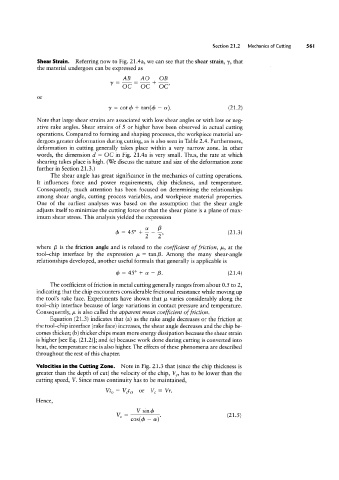Page 580 - 04. Subyek Engineering Materials - Manufacturing, Engineering and Technology SI 6th Edition - Serope Kalpakjian, Stephen Schmid (2009)
P. 580
Section 2 1.2 Mechanics of Cutting
Shear Strain. Referring now to Fig. 21.4a, we can see that the shear strain, y, that
the material undergoes can be expressed as
v=-=-+-1
AO
OB
AB
OC OC OC
or
7/ = cot<1> + tan(d> - oz). (21.2)
Note that large shear strains are associated with low shear angles or with low or neg-
ative rake angles. Shear strains of 5 or higher have been observed in actual cutting
operations. Compared to forming and shaping processes, the workpiece material un-
dergoes greater deformation during cutting, as is also seen in Table 2.4. Furthermore,
deformation in cutting generally takes place within a very narrow zone. In other
words, the dimension d = OC in Fig. 21.4a is very small. Thus, the rate at which
shearing takes place is high. (We discuss the nature and size of the deformation zone
further in Section 21.3.)
The shear angle has great significance in the mechanics of cutting operations.
It influences force and power requirements, chip thickness, and temperature.
Consequently, much attention has been focused on determining the relationships
among shear angle, cutting process variables, and workpiece material properties.
One of the earliest analyses was based on the assumption that the shear angle
adjusts itself to minimize the cutting force or that the shear plane is a plane of max-
imum shear stress. This analysis yielded the expression
¢=4y+§-Q, (mm
where ,B is the friction angle and is related to the coefncient of friction, /.L, at the
tool-chip interface by the expression /.L = tan B. Among the many shear-angle
relationships developed, another useful formula that generally is applicable is
¢=4v+a-5. (mm
The coefficient of friction in metal cutting generally ranges from about 0.5 to 2,
indicating that the chip encounters considerable frictional resistance while moving up
the tool’s rake face. Experiments have shown that /.L varies considerably along the
tool-chip interface because of large variations in contact pressure and temperature.
Consequently, /.L is also called the apparent mean coefhcient of friction.
Equation (21.3) indicates that (a) as the rake angle decreases or the friction at
the tool-chip interface (rake face) increases, the shear angle decreases and the chip be-
comes thicker; (b) thicker chips mean more energy dissipation because the shear strain
is higher [see Eq. (21.2)]; and (c) because work done during cutting is converted into
heat, the temperature rise is also higher. The effects of these phenomena are described
throughout the rest of this chapter.
Velocities in the Cutting Zone. Note in Fig. 21.3 that (since the chip thickness is
greater than the depth of cut) the velocity of the chip, VC, has to be lower than the
VC = .
cutting speed, V. Since mass continuity has to be maintained,
Vto = Veta, or VC = Vr.
Hence, V sind> (21.5)

